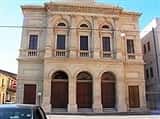Stay
Visit a locality browsing the menu on the left. In each Italy area you can then choose the best touristical structures we are proposing.
Most viewed in
Italy
-
Sunland since 1979 is the leading tour operator for ground hanling services on Amalfi Coast, Cilento and Neapolitan Riviera. Sunland is the partner of some of the biggest tour operator world wide. Our attentive staff is at your service for: Hotel accomodation...
-
The Amalfi Coast, suspended between sea and Sky, is a land of an amazing beauty. Our wish, having the pleasure to be your driver/guide, is to share with you the traditions, art, history, landscapes and the beauty that makes this land, " The Divine Amalfi...
-
Self-catering villas and apartments on the Amalfi Coast with pool, access to the sea and air conditioning. Amalfi Vacation owns and manages all the Amalfi Coast villas shown on the website. We are specialists in luxury villas and self-catering apartments...
-
Located on the famous AmalfiCoast drive, a few minutes from the famous town of Amalfi, the Santa Caterina enjoys a panoramic coastal setting of incomparable beauty. The history of this special resort is as impressive as its surroundings. In 1880, Giuseppe...
-
Situated on the last bend of Amalfi's promenade and beach, this hotel is on four levels. Bright and Mediterranean in style, the Marina Riviera is a converted old noble villa. All rooms are spacious & tastefully furnished, and have open windows or balconies...
Print this page
Send to a friend by e-mail
The Theatre Garibaldi
-

Strongly desired by Calogero Gubernale, major of Avola, the Theatre is next to the Town Hall and was planned by Salvatore Rizza on an area of 493 square meters, at first designed for St. Domenico's church factory. In was inaugurated on April, 20th 1876 and dedicated to Garibaldi in 1882, was later closed in the 40s of the last century and, later a long recovery restoration and consolidation, the Theatre was reopened to the public on April, 20th 2011. The elegant Renaissance frontage, made of Iblean white stones, dominates the homonymous square and some round arches are surmounted by balusters reminding of Palladio times. The interior is a real harmony's miracle. Some operators coming from St. Carlo of Naples worked on the scenic devices and scenography. The stalls, horseshoe shaped and surmounted by paterned golden tribunes over three floors, are exactly beyond the hallway. The Plafond features paintings representing the Dancing Muses and the Hallway's portraits by Gregorio Scalia. In the upstair foyer there is the permanent exhibition of the "Theatre's Faces: story and documents" that brings out news concering its edification and people involved.
(source: Avola, la città esagonale)